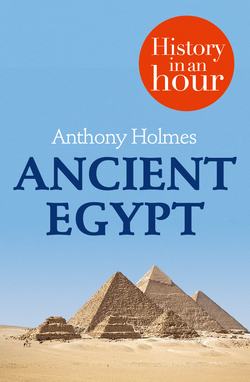Читать книгу Ancient Egypt: History in an Hour - Anthony Holmes, Anthony Holmes - Страница 6
ОглавлениеAncient Egyptian Civilization
‘Egypt is the gift of the Nile’ wrote the Greek historian Herodotus in c.400 BC. The River Nile was much more than a reliable source of water; the annual inundation resulting from melting snow and the rainfall in the highlands of Ethiopia brought with it the life-giving silt and nutrients that created the fertile strip of land along its banks. The Nile was the magnet that drew disparate tribes from the surrounding areas and, with its abundance of fish and water fowl, was also the reason for the consolidation of fragmented tribes into the nation called Egypt.
From c.4000 BC to the present day, the inhabited regions of Egypt have been restricted to areas of arable land plus some coastal towns and isolated oases in the Sahara Desert. The populated land is divided into two main areas. The first is the triangular delta region to the north where the Nile splits into branches and eventually flows into the Mediterranean Sea. The second area is the region to the south of the delta along the Nile to Egypt’s southern border with Sudan.
The Nile flows from south to north. To journey ‘upstream’ means to travel south, consequently the delta region to the north was called Lower Egypt. The region to the south, along the upper reaches of the Nile, was called Upper Egypt. In our modern convention of drawing maps with north at the top of the page, these names might seem back to front.
Once a society was established along its banks, the Egyptians used the Nile as their main artery for transport. Ships used the river’s strong current to voyage from south to north. On the return voyage, they hoisted a sail to capture the prevailing wind from the north and augmented their progress with oars to propel the vessels upstream to the south.
Egypt was not always as dry as it is now. Archaeological evidence revealed the existence of human habitation in south-west Egypt as early as c.8000 BC. During that period, the Egyptian climate was far wetter than it is today. Dramatic climate change around 8000 BC saw the gradual desertification of the grasslands and the formation of the Sahara Desert.
Ancient Egypt
The climate change that dried out western Egypt resulted in the rain moving eastwards. Tribes from the desiccated grasslands moved to the Nile valley and the delta, to take advantage of the seasonal flood of the Nile. The staple foods were already established as wheat and barley, with flax providing the raw material for fabric and rope production.
By c.6000 BC, Egyptians in the south-west were herding cattle and constructing buildings. Permanent settlements existed in c.5500 BC, when inhabitants focused on cereal growing and animal herding. Archaeologists have unearthed burial goods such as metal items, woven baskets, tanned animal hides, hunting tools and woven fabrics dated to c.5000 BC. The dead were buried facing west towards Libya, perhaps looking to their original homeland, and the concept that the western bank of the Nile was the realm of the dead was to remain a feature of Egyptian culture and was a belief that gave rise in modern times to the phrase ‘gone west’.
Naqada pottery
Artefacts from the period 5200 BC to 4000 BC discovered at Fayoum Oasis included stone axes, dolerite mace heads, arrowheads, stone palettes, pots, cups and stone beads. Furniture, tableware, decorated pots, combs made from bone and figurines all appeared around this time. Foreign artefacts relating to this period indicate contacts as distant as Lebanon and Syria.
The Naqada culture, named after the town of Nubt, meaning ‘city of gold’, commenced c.4000 BC and continued to c.3200 BC, a left pottery decorated with recognizable human and animal shapes. Potters made models of houses which were included in burial goods. Designs on pottery depicting humans and animals became more realistic by c.4000 BC, and techniques of stonework were developed. Tomb building, including the construction of underground storerooms, appeared in the second phase of the Naqada. The burial practices are recognizable as the early Osiris cult of ancient Egypt, and the decorations on the pottery resembled hieroglyphs.
